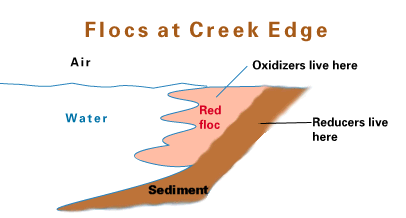
HOW TO COLLECT SLIMY FLOCCULATES (FLOCS)
Equipment
Vials, eyedropper, pen, small jar of chlorinated drinking water.

Red flocs show where iron-bearing anoxic ground water discharges
into Oxon Run, Md., a tributary of the Potomac River. The bacteria that
fixed the iron into flocculates (flocs) can be collected with eyedroppers
and vials. The loose floc is often made by Leptothrix ochracea.
Procedures
1. Think about the microbial population you want to collect and where
it may be: what color is being formed, how much oxygen do they need, do
they need sun (are they photosynthetic)?
How much oxygen do they tolerate?
aerobes = lots of oxygen, usually where water is moving
microaerophiles = little oxygen, water barely moving or not moving
anaerobes = no oxygen, water not moving, rotting plant material often present
What colors do you see?
red = oxidizers, either microaerophiles or aerobes
yellow = oxidizers, aerobes
white, possible sulfur smell = oxidizers, microaerophiles
purple, possible sulfur smell = photosynthetic, anaerobes
green, possible sulfur smell = photosynthetic, anaerobes
black = reducers, anaerobes
2. Label vial with place code, number, and date (for example, HM#1
4/22/96)
3. Do not use the same eyedropper for oxidizers and reducers (or
wash out the eyedropper with chlorinated drinking water)

An interesting place to compare bacteria is at redox boundaries,
where oxidizing and reducing environments meet. Here at Silver Lake fen,
Iowa, the oxidizers precipitate red iron and the reducers precipitate black
iron.
4. Collect all the different types:
Aerobes--Suction with eyedropper from the top edges of the floc,
and put a bunch into a vial; add creek water with eyedropper, but leave
air space at top of vial.
Microaerophiles--Suction with eyedropper from the
floc, and put a bunch into a vial; add creek water, and leave no air space
at top of vial.
Water column anaerobes--Suction with eyedropper from the floc, and put a bunch into a vial; add creek water until it flows
over the top of the vial to help eliminate oxygen.
Sediment anaerobes--Suction with eyedropper down into the black sediment,
and put some into a vial; add creek water until it flows over the top.
Experiments
1. Observe effects of change in the environment through time: collect
red flocculate (floc) in one vial. In a second vial, collect red floc and
then add a drop of black underlying mud--watch the reducers reduce the red
iron to brown and then black.
2. Start a pet bacteria collection: put the vials on windowsills
and look for changes in these microcosms over time; find a sunny windowsill
for the photosynthesizers; put sulfur bacteria samples in plastic bag so
they don't smell up the room.

Sometimes at Huntley Meadows wetland, Va., the bacteria that
oxidize iron float right on top of the water. Below them, the sediment has
the black color of reduced iron. Bacteria therefore can be used to learn
the location of the redox boundary, where oxidizing and reducing environments
meet within the water column.
Collecting Hint


Red coatings (precipitates) of iron attached to rocks, twigs,
roots, and flotsam are often formed by Gallionella ferruginea, shown
here at Jabez Creek, Md.
 Contents
Contents
"How To Collect Oil-Like Films"
Contact: Norrie Robbins
[an error occurred while processing this directive]






